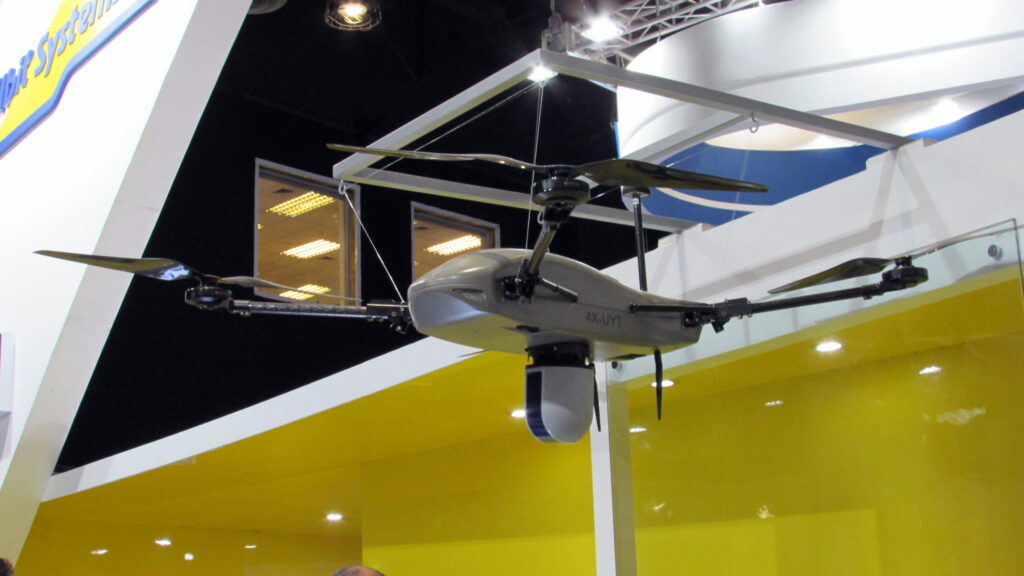For the second straight year, I attended the annual trade show of the Association for Unmanned Vehicle Systems International (AUVSI), the world’s largest nonprofit advocacy organization for what many refer to as “drones.” This August’s gathering took place on the huge floor of the Walter E. Washington Convention Center in the AUVSI’s home turf, Washington, D.C. With more than 8,000 attendees over four days, the ever-expanding event illustrates the recession-proof nature of the U.S. military-industrial complex.
A highlight of the more than 500 exhibitors was the Monrovia, California–based AeroVironment, Inc. A small contractor relative to the likes of Northrop Grumman and Lockheed Martin—which were also present—AeroVironment has seen dramatic growth since 9/11. According to the Los Angeles Times, the company’s annual sales have increased from $29.4 million to $292.5 million over the last decade, thanks to its “smaller, cheaper but powerful high-tech weapons” that are “vital to waging guerrilla-type warfare.”
One of the company’s biggest successes is the decade-old Raven, an unmanned aerial vehicle (UAV) that weighs less than five pounds, fits into a backpack, is easily assembled, and is launched by human power like throwing a paper airplane. The Raven, The Economist says, is “a flying pair of binoculars that can look over the next hill, or escort a convoy from above.” Ravens provide imagery mapped to GPS coordinates, have infrared-sensing capacity, and can mark people and objects with a laser for targeting by heavy firepower. All branches of the military use Ravens. Last year the U.S. Army alone bought almost 1,300 Ravens—at about $56,000 each—according to The Economist.
However, I took a greater interest in the “Switchblade,” AeroVironment’s new toy, advertised on constant video playback at the company’s booth.
The commercial begins with two armored vehicles driving through a rugged desert. Suddenly, several unidentified individuals—one of whom is wearing a keffiyeh, the traditional Arab headdress—hit the first vehicle with some sort of mortar. Four soldiers jump out of the vehicles, and immediately come under heavy gunfire.
“Launch the bird,” one of the soldiers yells. Another then withdraws a tube from a backpack, quickly stands it on its two legs, and launches a projectile that immediately takes flight and sprouts wings. The device, a small UAV, provides the operator with a view of the surrounding terrain. Once he spots the two shooters in the hills above, he locks in and directs the Switchblade, what is essentially a remotely piloted missile, to hit the targets.
“Two down,” he proudly hollers. The two remaining adversaries run into a waiting pickup truck. The operator launches another Switchblade, and soon the enemy vehicle explodes in flames.
“Got ‘em,” he yells, as triumphant music plays in the background. “Yeah,” his appreciative and relieved compatriots shout.
AeroVironment says the 5.5-pound Switchblade is “in development and user testing.” At the exhibition, none of the company’s representatives would tell me whether the Pentagon was already deploying the Switchblade in battle. But the buzz around the show suggested that the “magic bullet”—as AeroVironment’s brochure characterizes it—was already in use. A couple weeks after the show, the company announced that the U.S. Army has ordered more than $4.9 million worth of Switchblades.
Weapons such as the Switchblade increasingly enable the U.S. military to kill via remote control and greatly diminish the vulnerability of soldiers. The military and researchers are currently working on fully autonomous airplanes that use facial-recognition software to identify human targets, communicate with other unmanned vehicles to double-check the identities of the targets, and then, upon receiving confirmation, fire missiles at them. As I discussed in my Boston Review story at the beginning of this year, a number of analysts—such as Noel Sharkey, a professor of artificial intelligence and robotics at the U.K’s University of Sheffield—argue that these kinds of innovations create levels of asymmetry that make war increasingly like terrorism.
Qualms over these developments, however, certainly weren’t evident at AUVSI 2011.
“War is not a damn soccer game,” said John Riggs, a retired U.S. Army lieutenant general now working for North American division of QinetiQ, a British military contractor. “We’re not supposed to have equal sides.”
Or as another speaker proudly asserted, “We want unfair advantages.”








